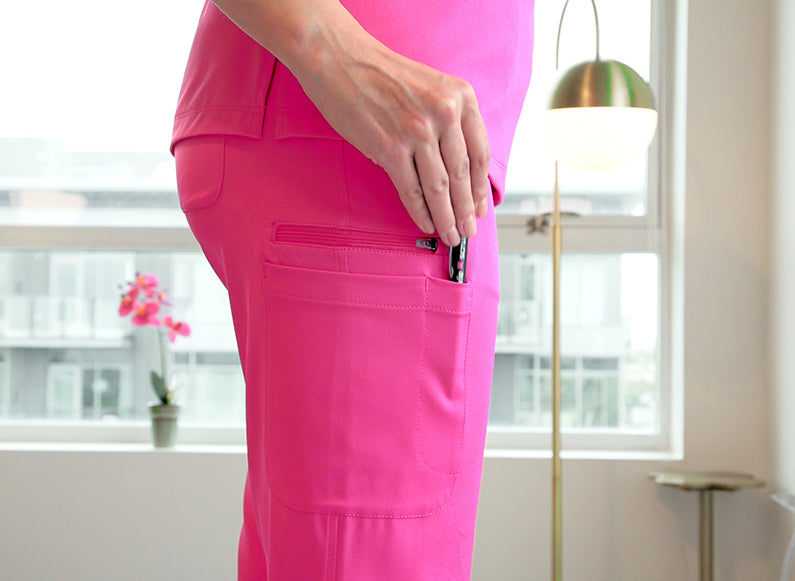Outpatient Nursing: A Work-Life-Health Balance Solution
Written by Mica Godwin, RN, BSN
Outpatient nursing is an appealing avenue to create real work-life balance.
With predictable schedules and lower patient acuity, outpatient nursing jobs are ideal for nurses who:
- have school-aged kids
- are caretakers for aging parents
- need a less physically demanding role
- need a change from the adrenaline rush of departments high acuity units such as the emergency room, NICU, PACU, or Labor and Delivery
- are fresh out of nursing school
Whether burnout, compassion fatigue, demands of the pandemic (or all of the above) have inspired you to re-evaluate beside nursing, we’re here to help you make the decision for your career, physical, and mental health.
A Perfect Schedule, Right?
A Monday-Friday, 0700-1600 schedule looks mighty fine after years of working 12 to 14-hour shifts (super long in even the most comfortable scrubs!), working nights, and mandatory overtime.
You’ll finally experience:
- a predictable schedule
- the health benefits of consistent sleep
- holidays off
- weekends with family and friends
Working five days a week, however, can be a hard adjustment. With only two days off to recover and accomplish your to-do list, the weekend feels much shorter. Requesting mid-week time off for your own doctor's appointments or the post office can quickly deplete paid time-off hours (PTO). However, recent advancements in online shopping, grocery delivery, and telehealth make this much easier!
Many outpatient clinics reduce their patient load or close entirely during the winter holidays. This allows you to have more time off, however, you may have to use PTO to accommodate these closures.
Weigh the Salary Difference
Due to lower patient acuity and no night or weekend shift differentials, outpatient clinics typically pay less than hospitals. The U.S. Bureau of Labor reports outpatient nurses make approximately 6% less than bedside nurses nationally.
Most outpatient nurses find the improved quality of life is worth the sacrifice. Don't sell yourself short, though. Know your worth, and be confident when negotiating your new salary.
Hone your Specialized Nursing Skills
Bedside nurses in medical scrubs are the jack of all trades-master of none. In outpatient settings, you have the opportunity to hone in on a specific skill set. Be ready to crack open your old anatomy and physiology textbook and become a master of one!
Brush up on your diversity training as well. Though patient acuity will be lower, your patient volume will more than double. Work on effective communication skills, active listening, and focused assessments.
Choose your Preferred Patient Relationship
Outpatient nursing allows you to choose a specialty that will reflect the patient relationship you value most.
Nurses who enjoy short bursts of quality nursing care for one-time patients prefer positions in gastroenterology (GI) or surgical centers.
For deeper, longer-lasting patient relationships, look for specialties that offer regular treatments for chronic disease or injuries such as dialysis, hospice, primary care, or infusion clinics. You become very familiar with these patients and their families over the course of their care in these settings.
Know your Patient Population
Understand the needs and nuances of your new patient population, that may now consist of Veterans, women, teens, or LGBTQ+, by taking advantage of the cultural sensitivity and diversity classes offered by your employer or other nursing education sites like the American Nursing Association.
For example, the patient population in a Veterans Affairs (V.A.) primary care clinic is 84% male who are an average of 58 years old. This is dramatically different patients nurses see in a pediatric or labor and delivery unit.
Check out these conferences happening in 2022 to learn about your patient population:
-
Mental Health America Forward Together: Recovery, Healing, Hope
-
Nursing World Conference Pioneering Spirit of Enriching the Nursing Profession
-
The Global Exchange Conference Mental Health, Addiction treatment, Holistic Wellness
-
International Conference Nursing Ethics and Nurse-Nurse Relationships
Enjoy!
Outpatient nursing is incredibly rewarding. The diverse patient population and numerous specialty areas provide opportunities for professional growth, while simplifying your daily workload. These five tips to transition into outpatient nursing, combined with your brilliant nursing brain, experience, open mind, and a whole lotta Moxie guarantees you’ll rock the outpatient world!
About the Author
Mica Godwin, RN, BSN, Pitching Wellness - Registered Nurse Writing Service, LLC, is a nurse medical writer specializing in Whole Health, Women, Veterans, LGBTQ+, Mental Health & Wellness. Over ten years of clinical experience provides a wealth of expertise to share far beyond the bedside into the world of content writing. Owner of Pitch Wellness – Registered Nurse Writing Service, LLC, Mica provides relevant, evidence-based health & wellness content across the continuum. She is also a mom of two extraordinary teenage daughters, Samantha & Riley, and two spoiled rescued dogs, Gunnar & Lego. When she isn’t providing care to Veterans at the VA, being a mom, or writing content she enjoys living the simpler pleasures in life: good company, good food, wine, music, health, a warm cup of tea, and whole lotta laughter.
References:
About Us – Moxie Scrubs, http://MoxieScrubs.com/pages/about-us, 2022. Retrieved 3/10/2022.
Continuing Education for Nurses (CE) | ANA Enterprise (nursingworld.org) retrieved 3/12/2022.
Registered Nurses : Occupational Outlook Handbook: : U.S. Bureau of Labor Statistics (bls.gov). 2021. Retrieved 3/11/2022.
Veteran Population - National Center for Veterans Analysis and Statistics (va.gov) retrieved 3/12/2022.





